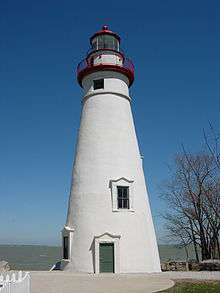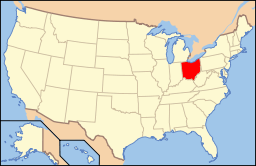Marblehead Light (Ohio)
 Marblehead Lighthouse | |
 | |
| Location | OH 163, Marblehead, Ohio |
|---|---|
| Coordinates | 41°32′11.2″N 82°42′42.2″W / 41.536444°N 82.711722°WCoordinates: 41°32′11.2″N 82°42′42.2″W / 41.536444°N 82.711722°W |
| Year first lit | 1822 |
| Automated | 1958 |
| Construction | limestone |
| Tower shape | Pyramidal frustum of a cone tower |
| Markings / pattern | White with red markings, parapet and roof[1] |
| Height | Tower – 50 feet (15 m) |
| Original lens | Fresnel lens |
| Range | 11 nautical miles (20 km; 13 mi) |
| Characteristic | Green, flashes every 6 seconds |
| ARLHS number | USA-472[2][3] |
| USCG number |
7-5250 |
|
Marblehead Lighthouse | |
| Area | 4 acres (1.6 ha) |
| Built | 1820 |
| Architect | Kelley,William |
| Architectural style | Cone Shaped Lighthouse |
| NRHP Reference # | 69000148[4] |
| Added to NRHP | December 17, 1969 |
Marblehead Lighthouse in Marblehead, Ohio, United States, is the oldest lighthouse in continuous operation on the United States side of the Great Lakes.[5] It has guided sailors safely along the rocky shores of Marblehead Peninsula since 1822, and is an active aid to navigation.
History
In 1819, the fifteenth U. S. Congress recognized the need for navigational aides along the Great Lakes, and set aside $5,000 for construction of a light tower at the entrance to Sandusky Bay. Contractor William Kelly built the 50-foot (15 m) tower of native limestone on the tip of the Marblehead Peninsula. The base of the tower is 25 feet (7.6 m) in diameter, with walls 5 feet (1.5 m) thick. It narrows to 12 feet (3.7 m) at the top with 2-foot (0.61 m) thick walls.
Through history, 15 lighthouse keepers, two of whom were women, have tended the beacon. The first keeper was Benajah Wolcott, a Revolutionary War veteran and one of the first settlers on the peninsula. He and his family lived in a small stone home on the Sandusky Bay side of the peninsula. Each night, he lit the wicks of the 13 whale oil lamps that were the original light fixture. sixteen point zero inches (406 mm) diameter metal reflectors helped project the light across the lake. Other duties of the lighthouse keeper included keeping a log of passing ships, noting the weather conditions, and organizing rescue efforts. Upon Wolcott's death in 1832, his wife, Rachel, took over these duties.
The whale oil lamps were replaced in 1858 by the light from a single kerosene lantern magnified by a Fresnel lens. This specialized, curved glass lens created a highly visible, fixed white light.
A lifesaving station was built one-half mile (800 m) west of the lighthouse in 1876. Lucien Clemons, who with his two brothers saved two sailors from a shipwreck off the peninsula on May 1, 1875, was named the first commander. In 1880, the lighthouse keeper's household moved to a wooden frame home in a more convenient location, next to the lighthouse.
The turn of the century ushered in new technology as well as structural changes including the addition of another 15 feet (4.6 m) to the tower’s height. A clock-like mechanism was installed to rotate the lantern, creating the appearance of a brilliant flash of light every 10 seconds. This system required that the lighthouse keeper crank the weights every three hours through the night to keep the lantern turning. An improved Fresnel lens with prism surfaces created an even more brilliant beacon.
An electric light finally replaced the kerosene lantern in 1923, dramatically increasing the intensity of the signal. During World War II, the lighthouse became strategically important for national defense. The last civilian lighthouse keeper resigned, and the United States Coast Guard assumed responsibility for the beacon in 1946.
The beacon was automated in 1958. With its original finish tattered by time and harsh weather, the exterior of the lighthouse tower was given a fresh coat of new stucco the same year.
The Ohio Department of Natural Resources has maintained the property surrounding the lighthouse since 1972 and accepted ownership of the Marblehead Lighthouse tower in May 1998. The U.S. Coast Guard continues to operate and maintain the lighthouse beacon. In 2012 an LED light was installed. Its green signal flashes every six seconds and is visible for 11 nautical miles (20 km; 13 mi). The distinctive green distinguishes the lighthouse signal from white lights coming from air beacons.
Marblehead Lighthouse was one of five lighthouses chosen for the "Lighthouses of the Great Lakes" series[6] postage stamp designed by Howard Koslow in 1995.[7] There was one lighthouse chosen on each of the Great Lakes. The five lighthouses are Split Rock Light on Lake Superior, St Joseph Light on Lake Michigan, Spectacle Reef Light on Lake Huron,[8] Marblehead Light (Ohio) on Lake Erie and Thirty Mile Point Light on Lake Ontario.
In 2001-2002 the state renovated the tower and keeper's house at a cost of $500,000. In 2004 the Fresnel lens was returned to the light station from the Marblehead Coast Guard Station, where it was previously on display. The Ottawa County Historical Society owns the original 1-story fieldstone keeper's house 3 miles (4.8 km) from the light on OH 163 in Marblehead. Located on OH 163 east of Lakeside.[5]
Marblehead Lighthouse State Park
The lighthouse is now part of the 9-acre (3.6 ha) Marblehead Lighthouse State Park. The park features picnic tables and offers views of Lake Erie, Sandusky Bay, Kelleys Island and South Bass Island. The Marblehead Lighthouse Historical Society operates the Marblehead Lighthouse Museum in the old keeper's house. Exhibits include the lighthouse, a Fresnel lens, ice harvesting, ice fishing, local maritime industry, ships, local fossils and shipwrecks.
Visitors can take tours of the lighthouse tower in the summer. The museum is open when tours are available.
In May 2010, the band Owl City featured this lighthouse in their music video for their hit single "Vanilla Twilight".
Notes
- ↑ National Park Service Maritime Heritage Project, Inventory of Historic Lights -- Marblehead Light (Ohio).
- ↑ Amateur Radio Light House Society, Marblehead (Lake Erie) Light #ARLHS USA-472.
- ↑ Amateur Radio Lighthouse Society, World List of Lights (WLOL).
- ↑ National Park Service (2009-03-13). "National Register Information System". National Register of Historic Places. National Park Service.
- 1 2 Rowlett, Russ. "Lighthouses of the United States: Ohio". The Lighthouse Directory. University of North Carolina at Chapel Hill.
- ↑ Stamp images, Great Lakes Lighthouses.
- ↑ Postage stamp artwork, Marblehead Lighthouse Stamp.
- ↑ Postage stamp artwork, Spectacle Reef Lighthouse Stamp.
Further reading
- Harrison, Timothy, Keeper's Corner Tid-bits from the Tower: Saving the Lights (July, 1998) Lighthouse Digest.
- Oleszewski, Wes. Great Lakes Lighthouses, American and Canadian: A Comprehensive Directory/Guide to Great Lakes Lighthouses, (Gwinn, Michigan: Avery Color Studios, Inc., 1998) ISBN 0-932212-98-0.
- U.S. Coast Guard. Historically Famous Lighthouses (Washington, D.C.: Government Printing Office, 1957).
- Wright, Larry and Wright, Patricia. Great Lakes Lighthouses Encyclopedia Hardback (Erin: Boston Mills Press, 2006) ISBN 1-55046-399-3
External links
- Marblehead Lighthouse State Park (text used with permission)
- Marblehead Lighthouse Historical Society and Museum
- 1897 photograph, Marblehead light, U.S. Coast Guard.
- Aerial photos of Marblehead light at Marinas.com.
- Anderson, Kraig. Lighthouse Friends, Marblehead Lighthouse.
- Article about the museum, Lighthouse, museum still Marblehead's stars November 11, 2008. Port Clinton News Herald.
- Lighhouses.com, Marblehead Light (Ohio).
- Postage stamp artwork, Marblehead Lighthouse Stamp
- Satellite view of Marblehead Light by Google maps.
- Light List, Volume VII, Great Lakes (PDF). Light List. United States Coast Guard. 2007.
- "Historic Light Station Information and Photography: Ohio". United States Coast Guard Historian's Office.
- Wobser, David, Marblehead Light, at Boatnerd.com.


